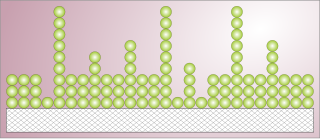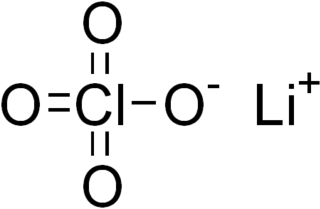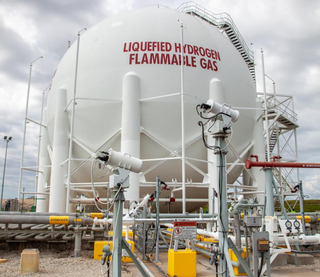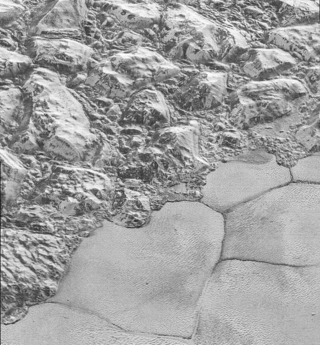Related Research Articles
Surface science is the study of physical and chemical phenomena that occur at the interface of two phases, including solid–liquid interfaces, solid–gas interfaces, solid–vacuum interfaces, and liquid–gas interfaces. It includes the fields of surface chemistry and surface physics. Some related practical applications are classed as surface engineering. The science encompasses concepts such as heterogeneous catalysis, semiconductor device fabrication, fuel cells, self-assembled monolayers, and adhesives. Surface science is closely related to interface and colloid science. Interfacial chemistry and physics are common subjects for both. The methods are different. In addition, interface and colloid science studies macroscopic phenomena that occur in heterogeneous systems due to peculiarities of interfaces.
Chemisorption is a kind of adsorption which involves a chemical reaction between the surface and the adsorbate. New chemical bonds are generated at the adsorbent surface. Examples include macroscopic phenomena that can be very obvious, like corrosion, and subtler effects associated with heterogeneous catalysis, where the catalyst and reactants are in different phases. The strong interaction between the adsorbate and the substrate surface creates new types of electronic bonds.

Adsorption is the adhesion of atoms, ions or molecules from a gas, liquid or dissolved solid to a surface. This process creates a film of the adsorbate on the surface of the adsorbent. This process differs from absorption, in which a fluid is dissolved by or permeates a liquid or solid. While adsorption does often precede absorption, which involves the transfer of the absorbate into the volume of the absorbent material, alternatively, adsorption is distinctly a surface phenomenon, wherein the adsorbate does not penetrate through the material surface and into the bulk of the adsorbent. The term sorption encompasses both adsorption and absorption, and desorption is the reverse of sorption.

The third law of thermodynamics states that the entropy of a closed system at thermodynamic equilibrium approaches a constant value when its temperature approaches absolute zero. This constant value cannot depend on any other parameters characterizing the system, such as pressure or applied magnetic field. At absolute zero the system must be in a state with the minimum possible energy.

In thermodynamics, the Gibbs free energy is a thermodynamic potential that can be used to calculate the maximum amount of work, other than pressure-volume work, that may be performed by a thermodynamically closed system at constant temperature and pressure. It also provides a necessary condition for processes such as chemical reactions that may occur under these conditions. The Gibbs free energy is expressed as
Palladium hydride is metallic palladium that contains a substantial quantity of hydrogen within its crystal lattice. Despite its name, it is not an ionic hydride but rather an alloy of palladium with metallic hydrogen that can be written PdHx. At room temperature, palladium hydrides may contain two crystalline phases, α and β. Pure α-phase exists at x < 0.017 whereas pure β-phase is realised for x > 0.58; intermediate x values correspond to α-β mixtures.

Potassium chlorate is a compound containing potassium, chlorine and oxygen, with the molecular formula KClO3. In its pure form, it is a white crystalline substance. After sodium chlorate, it is the second most common chlorate in industrial use. It is a strong oxidizing agent and its most important application is in safety matches. In other applications it is mostly obsolete and has been replaced by safer alternatives in recent decades. It has been used

An isothermal process is a type of thermodynamic process in which the temperature T of a system remains constant: ΔT = 0. This typically occurs when a system is in contact with an outside thermal reservoir, and a change in the system occurs slowly enough to allow the system to be continuously adjusted to the temperature of the reservoir through heat exchange (see quasi-equilibrium). In contrast, an adiabatic process is where a system exchanges no heat with its surroundings (Q = 0).

Ice Ih is the hexagonal crystal form of ordinary ice, or frozen water. Virtually all ice in the biosphere is ice Ih, with the exception only of a small amount of ice Ic that is occasionally present in the upper atmosphere. Ice Ih exhibits many peculiar properties that are relevant to the existence of life and regulation of global climate. For a description of these properties, see Ice, which deals primarily with ice Ih.

Lithium perchlorate is the inorganic compound with the formula LiClO4. This white or colourless crystalline salt is noteworthy for its high solubility in many solvents. It exists both in anhydrous form and as a trihydrate.
A chemical oxygen generator is a device that releases oxygen via a chemical reaction. The oxygen source is usually an inorganic superoxide, chlorate, or perchlorate. Ozonides are a promising group of oxygen sources, as well. The generators are usually ignited by a firing pin, and the chemical reaction is usually exothermic, making the generator a potential fire hazard. Potassium superoxide was used as an oxygen source on early crewed missions of the Soviet space program, in submarines for use in emergency situations, for firefighters, and for mine rescue.

Pressure swing adsorption (PSA) is a technique used to separate some gas species from a mixture of gases under pressure according to the species' molecular characteristics and affinity for an adsorbent material. It operates at near-ambient temperature and significantly differs from the cryogenic distillation commonly used to separate gases. Selective adsorbent materials are used as trapping material, preferentially adsorbing the target gas species at high pressure. The process then swings to low pressure to desorb the adsorbed gas.
In thermodynamics, the entropy of mixing is the increase in the total entropy when several initially separate systems of different composition, each in a thermodynamic state of internal equilibrium, are mixed without chemical reaction by the thermodynamic operation of removal of impermeable partition(s) between them, followed by a time for establishment of a new thermodynamic state of internal equilibrium in the new unpartitioned closed system.

Birnessite (nominally MnO2·nH2O), also known as δ-MnO2, is a hydrous manganese dioxide mineral with a chemical formula of Na0.7Ca0.3Mn7O14·2.8H2O. It is the main manganese mineral species at the Earth's surface, and commonly occurs as fine-grained, poorly crystallized aggregates in soils, sediments, grain and rock coatings (e.g., desert varnish), and marine ferromanganese nodules and crusts. It was discovered at Birness, Aberdeenshire, Scotland.

Several methods exist for storing hydrogen. These include mechanical approaches such as using high pressures and low temperatures, or employing chemical compounds that release H2 upon demand. While large amounts of hydrogen are produced by various industries, it is mostly consumed at the site of production, notably for the synthesis of ammonia. For many years hydrogen has been stored as compressed gas or cryogenic liquid, and transported as such in cylinders, tubes, and cryogenic tanks for use in industry or as propellant in space programs. The overarching challenge is the very low boiling point of H2: it boils around 20.268 K (−252.882 °C or −423.188 °F). Achieving such low temperatures requires expending significant energy.

In thermodynamics, the enthalpy of fusion of a substance, also known as (latent) heat of fusion, is the change in its enthalpy resulting from providing energy, typically heat, to a specific quantity of the substance to change its state from a solid to a liquid, at constant pressure.
Transition metal oxides are compounds composed of oxygen atoms bound to transition metals. They are commonly utilized for their catalytic activity and semiconducting properties. Transition metal oxides are also frequently used as pigments in paints and plastics, most notably titanium dioxide. Transition metal oxides have a wide variety of surface structures which affect the surface energy of these compounds and influence their chemical properties. The relative acidity and basicity of the atoms present on the surface of metal oxides are also affected by the coordination of the metal cation and oxygen anion, which alter the catalytic properties of these compounds. For this reason, structural defects in transition metal oxides greatly influence their catalytic properties. The acidic and basic sites on the surface of metal oxides are commonly characterized via infrared spectroscopy, calorimetry among other techniques. Transition metal oxides can also undergo photo-assisted adsorption and desorption that alter their electrical conductivity. One of the more researched properties of these compounds is their response to electromagnetic radiation, which makes them useful catalysts for redox reactions, isotope exchange and specialized surfaces.

Titanium disulfide is an inorganic compound with the formula TiS2. A golden yellow solid with high electrical conductivity, it belongs to a group of compounds called transition metal dichalcogenides, which consist of the stoichiometry ME2. TiS2 has been employed as a cathode material in rechargeable batteries.

Solid nitrogen is a number of solid forms of the element nitrogen, first observed in 1884. Solid nitrogen is mainly the subject of academic research, but low-temperature, low-pressure solid nitrogen is a substantial component of bodies in the outer Solar System and high-temperature, high-pressure solid nitrogen is a powerful explosive, with higher energy density than any other non-nuclear material.

Ice XVII is a metastable form of ice with a hexagonal structure and helical channels that was discovered in 2016. It can be formed by freezing water with hydrogen molecules at high pressure to form a filled ice, and then removing the hydrogen molecules from the structure. The form has potential for being used in hydrogen storage. Ice XVII made from heavy water can also be reduced to pure cubic ice.
References
- ↑ "Oxygen and Human Requirements". newton.dep.anl.gov. 2006-09-25. Archived from the original on 2015-02-26.
- ↑ 2 meter x 2 meter x 2.5 meter = 10 meter3 times concentration and density of oxygen at STP
- ↑ "High-Pressure Stainless Steel Cylinders Specifications". alspecialtygases.com. Archived from the original on 2010-03-15.
{{cite web}}: CS1 maint: unfit URL (link) - ↑ Solomon, Irvine J.; Kacmarek, Andrew J.; McDonough, John M.; Hattori, Kiyo (1960). "Preparation, Characterization and Physical and Chemical Properties of Tetramethylammonium Ozonide1". Journal of the American Chemical Society. American Chemical Society (ACS). 82 (21): 5640–5641. doi:10.1021/ja01506a022. ISSN 0002-7863.
- ↑ U.S. patent 3,139,327
- ↑ Klimkowicz, Alicja; Świerczek, Konrad; Zheng, Kun; Wallacher, Dirk; Takasaki, Akito (June 2017). "Oxygen release from BaLnMn2O6 (Ln: Pr, Nd, Y) under reducing conditions as studied by neutron diffraction". Journal of Materials Science. 52 (11): 6476–6485. Bibcode:2017JMatS..52.6476K. doi:10.1007/s10853-017-0883-2. ISSN 0022-2461. S2CID 99417756.
- ↑ Klimkowicz, Alicja; Świerczek, Konrad; Takasaki, Akito; Dabrowski, Bogdan (April 2014). "Oxygen storage capability in Co- and Fe-containing perovskite-type oxides". Solid State Ionics. 257: 23–28. doi:10.1016/j.ssi.2014.01.018.
- ↑ Klimkowicz, Alicja; Świerczek, Konrad; Kobayashi, Shuntaro; Takasaki, Akito; Allahyani, Wadiah; Dabrowski, Bogdan (February 2018). "Improvement of oxygen storage properties of hexagonal YMnO3+δ by microstructural modifications". Journal of Solid State Chemistry. 258: 471–476. Bibcode:2018JSSCh.258..471K. doi:10.1016/j.jssc.2017.10.037.
- ↑ Klimkowicz, Alicja; Cichy, Kacper; Chmaissem, Omar; Dabrowski, Bogdan; Poudel, Bisham; Świerczek, Konrad; Taddei, Keith M.; Takasaki, Akito (2019). "Reversible oxygen intercalation in hexagonal Y 0.7 Tb 0.3 MnO 3+δ : toward oxygen production by temperature-swing absorption in air". Journal of Materials Chemistry A. 7 (6): 2608–2618. doi:10.1039/C8TA09235D. ISSN 2050-7488. OSTI 1491217. S2CID 104445894.
- ↑ Sundberg, Jonas; Cameron, Lisa J.; Southon, Peter D.; Kepert, Cameron J.; McKenzie, Christine J. (2014). "Oxygen chemisorption/desorption in a reversible single-crystal-to-single-crystal transformation" (PDF). Chemical Science. 5 (10): 4017. doi: 10.1039/C4SC01636J . ISSN 2041-6520.
- ↑ Sundberg, Jonas; Cameron, Lisa J.; Southon, Peter D.; Kepert, Cameron J.; McKenzie, Christine J. (2014). "Oxygen chemisorption/desorption in a reversible single-crystal-to-single-crystal transformation". Chem. Sci. Royal Society of Chemistry (RSC). 5 (10): 4017–4025. doi: 10.1039/c4sc01636j . ISSN 2041-6520.